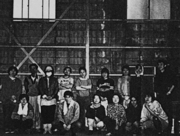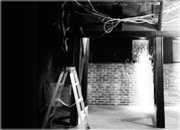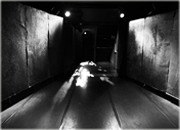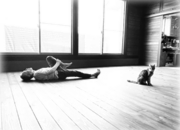Profile
 Gekidan Kaitaisha was organized in 1985. We advocated ‘theatre of space’, playing outdoor performance at stations, roads, riversides, parks, etc. Furthermore, we created Yugyo no Keshiki -The Drifting View, in which we planed new generation and transformation of theatre space, by changing performing areas one after another (with audience) in one performance instead of fixing audience seats. We toured this program in Toga Festival (’89, ‘95), Hinoemata Performance Festival (’86-‘89), Atlanta Festival (‘93), and so on. We opened our atelier, Kenzosha in Inukura, Kawasaki city in 1988.
Gekidan Kaitaisha was organized in 1985. We advocated ‘theatre of space’, playing outdoor performance at stations, roads, riversides, parks, etc. Furthermore, we created Yugyo no Keshiki -The Drifting View, in which we planed new generation and transformation of theatre space, by changing performing areas one after another (with audience) in one performance instead of fixing audience seats. We toured this program in Toga Festival (’89, ‘95), Hinoemata Performance Festival (’86-‘89), Atlanta Festival (‘93), and so on. We opened our atelier, Kenzosha in Inukura, Kawasaki city in 1988.
 In 1993, we moved to Hongo, Bunkyo ward, and opened our new atelier, Hongo DOK. Based on this place, exploring ‘theatre of corporeality’, we worked on criticism against ‘the human corporeality’ and the power/violence aiming at this corporeality. Our works from 1990’s to early 2000’s represented by Tokyo Ghetto and Bye-Bye, created from these inquiring and having the theme of ‘the war corporeality’, were invited from Japanese and foreign famous pioneering festivals, such as Tokyo International Festival (’95, ‘96), Eurokaz Festival (Zagreb ’96, ‘97), and Laokoon Summer Festival (Kampnagel, Hamburg ‘01). We had a reputation that ‘Gekidan Kaitaisha was one of the most influential experimental theatre groups in the world avant-garde theatre scene’.
In 1993, we moved to Hongo, Bunkyo ward, and opened our new atelier, Hongo DOK. Based on this place, exploring ‘theatre of corporeality’, we worked on criticism against ‘the human corporeality’ and the power/violence aiming at this corporeality. Our works from 1990’s to early 2000’s represented by Tokyo Ghetto and Bye-Bye, created from these inquiring and having the theme of ‘the war corporeality’, were invited from Japanese and foreign famous pioneering festivals, such as Tokyo International Festival (’95, ‘96), Eurokaz Festival (Zagreb ’96, ‘97), and Laokoon Summer Festival (Kampnagel, Hamburg ‘01). We had a reputation that ‘Gekidan Kaitaisha was one of the most influential experimental theatre groups in the world avant-garde theatre scene’.
 From 2004, Shimizu Shinjin, the director of our group, and interested members started the international collaboration series that named Dream Regime to consider ‘physical representation of bio-politics’ in the globalization after 9.11. Staying in the fields for a long term, we have collaborated with performers, artists and researchers of foreign countries, aiming for the performance in which theatre becomes "the test site of the thought". To date, we have developed the series of performances and residence in Wales, Jordan, Brazil, East Timor, U.K, Germany, Australia, Denmark, Poland and Japan for inquiring the hidden 20th century’s history of mobile and multi-layered many cultural spheres.
From 2004, Shimizu Shinjin, the director of our group, and interested members started the international collaboration series that named Dream Regime to consider ‘physical representation of bio-politics’ in the globalization after 9.11. Staying in the fields for a long term, we have collaborated with performers, artists and researchers of foreign countries, aiming for the performance in which theatre becomes "the test site of the thought". To date, we have developed the series of performances and residence in Wales, Jordan, Brazil, East Timor, U.K, Germany, Australia, Denmark, Poland and Japan for inquiring the hidden 20th century’s history of mobile and multi-layered many cultural spheres.
 In 2011, we planned another international coproduction work that named Posthuman Theatre in order to respond to the contemporary situation of ‘human being forgetting the history and animalizing’ that Alexandre Kojève had described. The collaborator is Theatre Cinema, the Polish avant-garde theatre group ‘after Tadeusz Kantor’. As a beginning, we made performances in Morishita Studio (Tokyo), and in 2012 we performed a tour of Poland and Germany.. This project, featuring the theme of ‘the loss of gestures’ and the recovery from this state, is attracting attentions from the various quarters as “the experimental stage indicating the distance from ‘the contemporary theatre after 3.11’.”
In 2011, we planned another international coproduction work that named Posthuman Theatre in order to respond to the contemporary situation of ‘human being forgetting the history and animalizing’ that Alexandre Kojève had described. The collaborator is Theatre Cinema, the Polish avant-garde theatre group ‘after Tadeusz Kantor’. As a beginning, we made performances in Morishita Studio (Tokyo), and in 2012 we performed a tour of Poland and Germany.. This project, featuring the theme of ‘the loss of gestures’ and the recovery from this state, is attracting attentions from the various quarters as “the experimental stage indicating the distance from ‘the contemporary theatre after 3.11’.”
 In 2012, "Sanaezaka Studio" which had been a private house, was opened in Ichigaya, Tokyo.
In 2012, "Sanaezaka Studio" which had been a private house, was opened in Ichigaya, Tokyo.
Since then, based here, we have presented a series of works with the theme of regenerating "the contraindicated words and bodies"-"INFANT" ('13 -'14) and "Festum" ('17). From 2015, we have presented the series"Céline's Century" ('15 -'18), inspired by Louis-Ferdinand Céline, a "war criminal writer" who is one of the most privileged novelist in 20th century world literature. Possessed by Céline's texts and bodies, that continue to accuse "Total War" , none other than our daily lives, we were challenging to revive the lost "drama of testimony".
 In 2019, Kaitaisha planed the "Project of Live-human body's languages" through the decipherment of Tatsumi Hijikata's idea of "taxidermy"which will communicate with “Theatre of possession”.
In 2019, Kaitaisha planed the "Project of Live-human body's languages" through the decipherment of Tatsumi Hijikata's idea of "taxidermy"which will communicate with “Theatre of possession”.
It is the project that we tried to generate "Live-human body's languages" on stage, as a horizon where our physical methods that we have been working on for many years and unique language groups meet. Now we are in the middle of that attempt.
 In 2023, Kaitaisha has opened a rehearsal space and theatre named "Hachioji Dock" in Ueno-mahi, Hachioji City, Tokyo.
In 2023, Kaitaisha has opened a rehearsal space and theatre named "Hachioji Dock" in Ueno-mahi, Hachioji City, Tokyo.
Designed by Toshiya Ochiai, an architect who hosts the Institute for Forest and Environmental Architecture, the theatre space resembles the hold of a wooden ship, and will serve as a new base for the company's activities.

